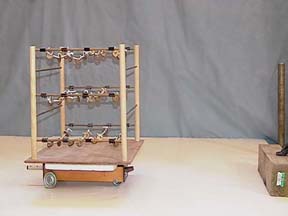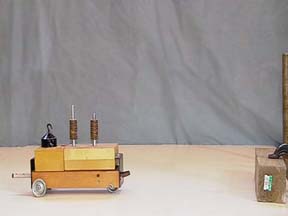TEST KEEP CLOSED
MECHANICS
Mechanics
- The Monkey and The Hunter
- Simultaneously Shoot and Drop Pair of Spheres
- Projectile Launched Vertically from a Moving Cart
Newt's Laws of Motion
- Newton's First Law
- Newton's Second Law
- Newton's Third Law
- Blackboard Mechanics Kit
- Cork Bob Accelerometer
Work and Energy
- Bowling Ball Pendulum
- Blocked Pendulum
- Loop-The-Loop
- Coefficients of Friction
- Friction Cart
- Energy Stored in a Spring
Mechanical Equilibrium
Collisions and Conservation of Momentum
- Explosions
- Totally Inelastic Collisions
- Elastic Collisions
- Newton's Collision Apparatus
- Internal Degrees of Freedom
Circular Motion
- Balls in Rotating Cups
- Loop-the-Loop
- Elastic Collisions
- Swinging Water Bucket Overhead
- Conical Pendulum
Rigid Body Rotations
OSCILLATIONS AND WAVES
Periodic Motion
Driven Oscillations and Resonance Phenomena
- Driven, Damped Harmonic Oscillator
- Resonance with a Speaker and Adjustable Pipe
- Driven Pendulum
- Modes of Vibration
- Compound Pendulum
- Chaotic Oscillations
Propagation of Mechanical Waves
Superposition of Waves
Normal Modes of Vibration
Acoustic Phenomena
OPTICS
Geometrical Optics
- Blackboard Optics Kit
- Dispersion in a Prism
- Total Internal Reflection
- Fiber Optic Cables
- Speed of Light
Interference and Diffraction
- Single Slit
- Double Slit
- Multiple Slits and Gratings
- Thin Film Interference:
- Newton's Rings
- Poisson's Spot
- Michelson Interferometer
Polarization
THERMAL PROPERTIES OF MATTER
Thermal Expansion
Thermal Conductivity
THERMODYNAMICS
Pressure-Volume-Temperature Relationships
- Adiabatic Gas Law
- Pressure Differences
- Model Lung
- Boyle's Law
- V-T Relationship at Constant Pressure
- P-V-T Surface for Water
- Diffusion Through an Aperture
- P-T Relation at Constant Volume
Many Particle Systems
ELECTRICITY & MAGNETISM
Electric Charge and Field
- Positive and Negative Charge by Friction
- Induced Surface Charge on Conductors
- Coulomb's Law
- Distribution of Surface Charge on Conductors
- Capacitors and Energy Storage
- Capacitance vs. Plate Separation
- Van de Graaff
- Jacob's Ladder
- Electric Field Lines
- Force on a Moving Charge in an Electric Field
- Flux Surface and Volume
Current and Resistance
- Resistors in Series and Parallel
- Internal Resistance of a Battery
- Ohmic and Non-Ohmic Devices
- Drift Velocity Demonstrator
- Wire Fryer (DC version)
Magnetic Field and Forces on Currents
- Magnetic Domain Model
- Magnetic Field of Permanent Magnets
- Earth's Magnetic Field: Dip Needle
- Magnetic Field of Currents
- Magnetic Field of a Solenoid
- Magnetic Force on an Electron Beam:
- Magnetic Force on a Current-Carrying Wire
- Magnetic Torque on a Current Loop
- Force Between Current-Carrying Wires
Induced Currents and EMF
- Faraday's Law and Lenz's Law
- Enclosed Fields and Magnetic Induction
- Current Generators
- DC Motors
- Eddy Currents:
- Jumping Rings
- Wire Fryer AC
- Transformers and Flux Linkage
- Self-Inductance and Energy Storage
- Displacement Current
Time Dependent Currents
Superconductivity
Electromagnetic Waves
ATOMIC AND NUCLEAR PROCESSES
Quantum Physics
Nuclear and Particle Physics
VISUAL AIDS
Internal Degrees of Freedom During Collisions
This demonstration is designed to help students understand what goes on at the microscopic level during collisions. The system on the left consists of an array of lead fishing sinkers suspended from springs inside a rigid frame. This can be thought of as representing a crystalline solid (the jiggling masses on springs representing lattice vibrations). The frame is mounted on a roller cart with an elastic steel bumper at one end. The cart is rolled across the lecture bench and collides with a fixed barrier, whereupon most of the initial kinetic energy is transferred irreversibly to lattice vibrations of the crystal model.
A more elastic collision results if the vibrating crystal model is replaced with rigidly mounted objects of comparable total mass. The photo on the right shows the same roller cart with a set of masses which have been wedged into a suitable holder to prevent them from sliding with respect to the cart during collision. The rebound kinetic energy of this system is nearly equal to the initial kinetic energy, in contrast to the vibrating crystal model, which absorbs most of the energy during the collision.

